Construction Research Project: Review of Energy Use Models in NZ Homes
VerifiedAdded on 2022/09/25
|56
|17254
|22
Report
AI Summary
This report presents a comprehensive review of energy use modeling in New Zealand homes, examining the significance of energy in modern society and the increasing demand for sustainable energy sources. It analyzes the residential sector's energy consumption, which accounts for a substantial portion of both total energy and electricity usage in New Zealand, contributing to greenhouse gas emissions. The review explores the shift towards renewable energy sources and compares energy consumption patterns across various sectors, including industry, transportation, and domestic use. It delves into international studies on home energy use, highlighting the impact of climate, living standards, and lifestyles on energy consumption. The report reviews several articles focusing on energy modeling techniques, such as engineering models, conditional demand analysis, and neural network models, to predict energy usage in homes. It also examines how these models are utilized in New Zealand and other countries like Australia, the US, and the UK to forecast future energy demands and greenhouse gas emissions. The report emphasizes the importance of energy management, sustainable energy plans, and the adoption of prediction tools to track and efficiently utilize energy consumption in households.
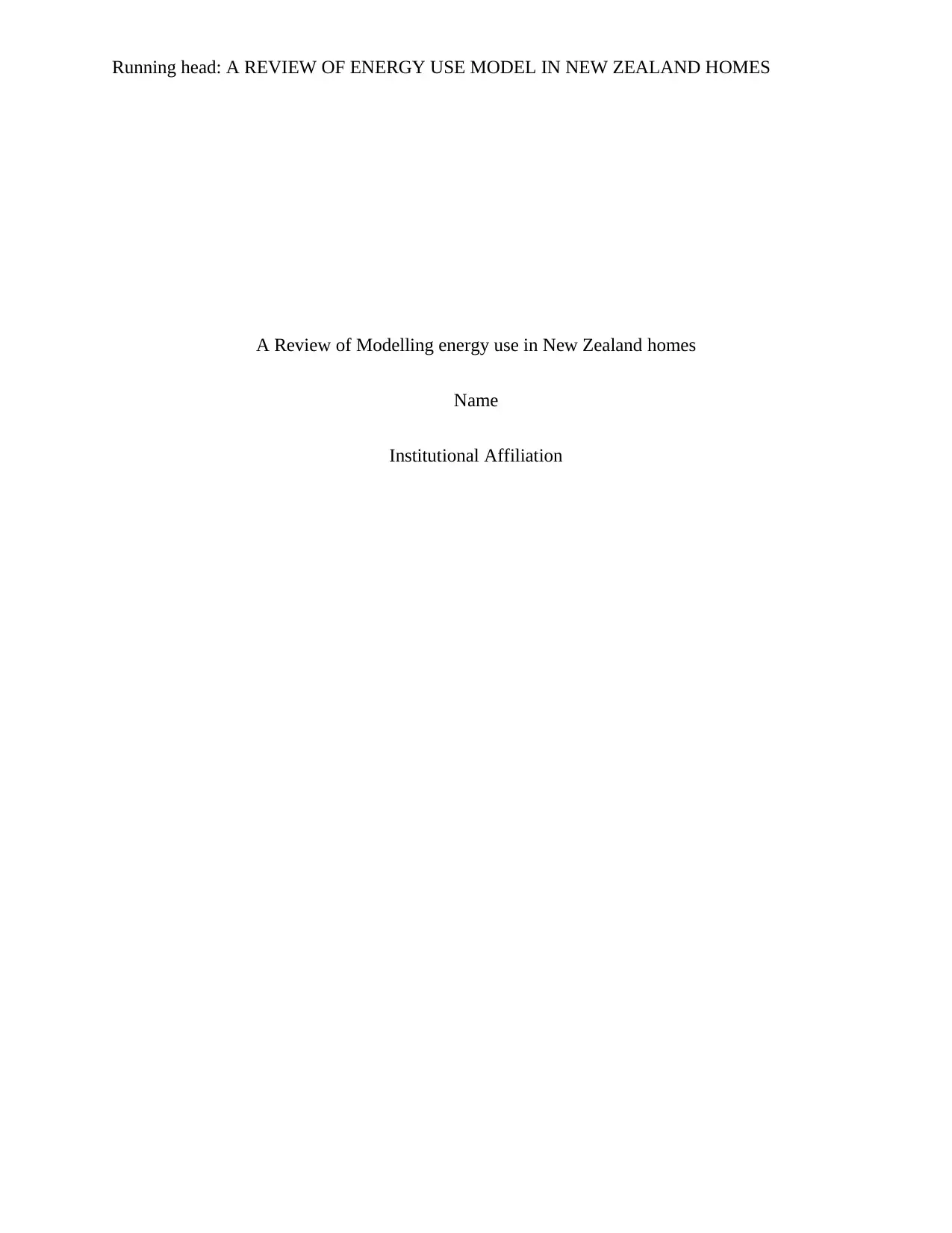
Running head: A REVIEW OF ENERGY USE MODEL IN NEW ZEALAND HOMES
A Review of Modelling energy use in New Zealand homes
Name
Institutional Affiliation
A Review of Modelling energy use in New Zealand homes
Name
Institutional Affiliation
Paraphrase This Document
Need a fresh take? Get an instant paraphrase of this document with our AI Paraphraser
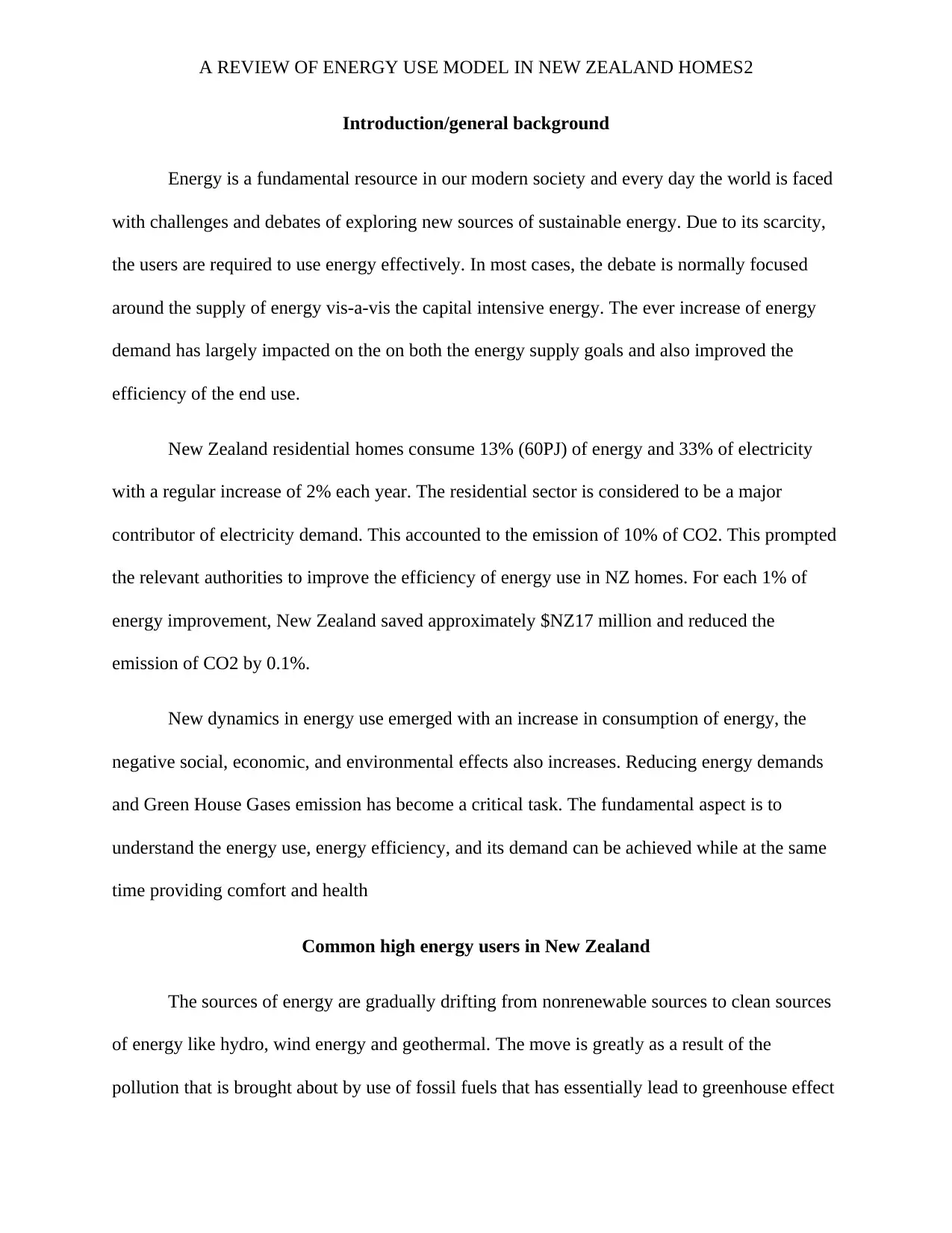
A REVIEW OF ENERGY USE MODEL IN NEW ZEALAND HOMES2
Introduction/general background
Energy is a fundamental resource in our modern society and every day the world is faced
with challenges and debates of exploring new sources of sustainable energy. Due to its scarcity,
the users are required to use energy effectively. In most cases, the debate is normally focused
around the supply of energy vis-a-vis the capital intensive energy. The ever increase of energy
demand has largely impacted on the on both the energy supply goals and also improved the
efficiency of the end use.
New Zealand residential homes consume 13% (60PJ) of energy and 33% of electricity
with a regular increase of 2% each year. The residential sector is considered to be a major
contributor of electricity demand. This accounted to the emission of 10% of CO2. This prompted
the relevant authorities to improve the efficiency of energy use in NZ homes. For each 1% of
energy improvement, New Zealand saved approximately $NZ17 million and reduced the
emission of CO2 by 0.1%.
New dynamics in energy use emerged with an increase in consumption of energy, the
negative social, economic, and environmental effects also increases. Reducing energy demands
and Green House Gases emission has become a critical task. The fundamental aspect is to
understand the energy use, energy efficiency, and its demand can be achieved while at the same
time providing comfort and health
Common high energy users in New Zealand
The sources of energy are gradually drifting from nonrenewable sources to clean sources
of energy like hydro, wind energy and geothermal. The move is greatly as a result of the
pollution that is brought about by use of fossil fuels that has essentially lead to greenhouse effect
Introduction/general background
Energy is a fundamental resource in our modern society and every day the world is faced
with challenges and debates of exploring new sources of sustainable energy. Due to its scarcity,
the users are required to use energy effectively. In most cases, the debate is normally focused
around the supply of energy vis-a-vis the capital intensive energy. The ever increase of energy
demand has largely impacted on the on both the energy supply goals and also improved the
efficiency of the end use.
New Zealand residential homes consume 13% (60PJ) of energy and 33% of electricity
with a regular increase of 2% each year. The residential sector is considered to be a major
contributor of electricity demand. This accounted to the emission of 10% of CO2. This prompted
the relevant authorities to improve the efficiency of energy use in NZ homes. For each 1% of
energy improvement, New Zealand saved approximately $NZ17 million and reduced the
emission of CO2 by 0.1%.
New dynamics in energy use emerged with an increase in consumption of energy, the
negative social, economic, and environmental effects also increases. Reducing energy demands
and Green House Gases emission has become a critical task. The fundamental aspect is to
understand the energy use, energy efficiency, and its demand can be achieved while at the same
time providing comfort and health
Common high energy users in New Zealand
The sources of energy are gradually drifting from nonrenewable sources to clean sources
of energy like hydro, wind energy and geothermal. The move is greatly as a result of the
pollution that is brought about by use of fossil fuels that has essentially lead to greenhouse effect
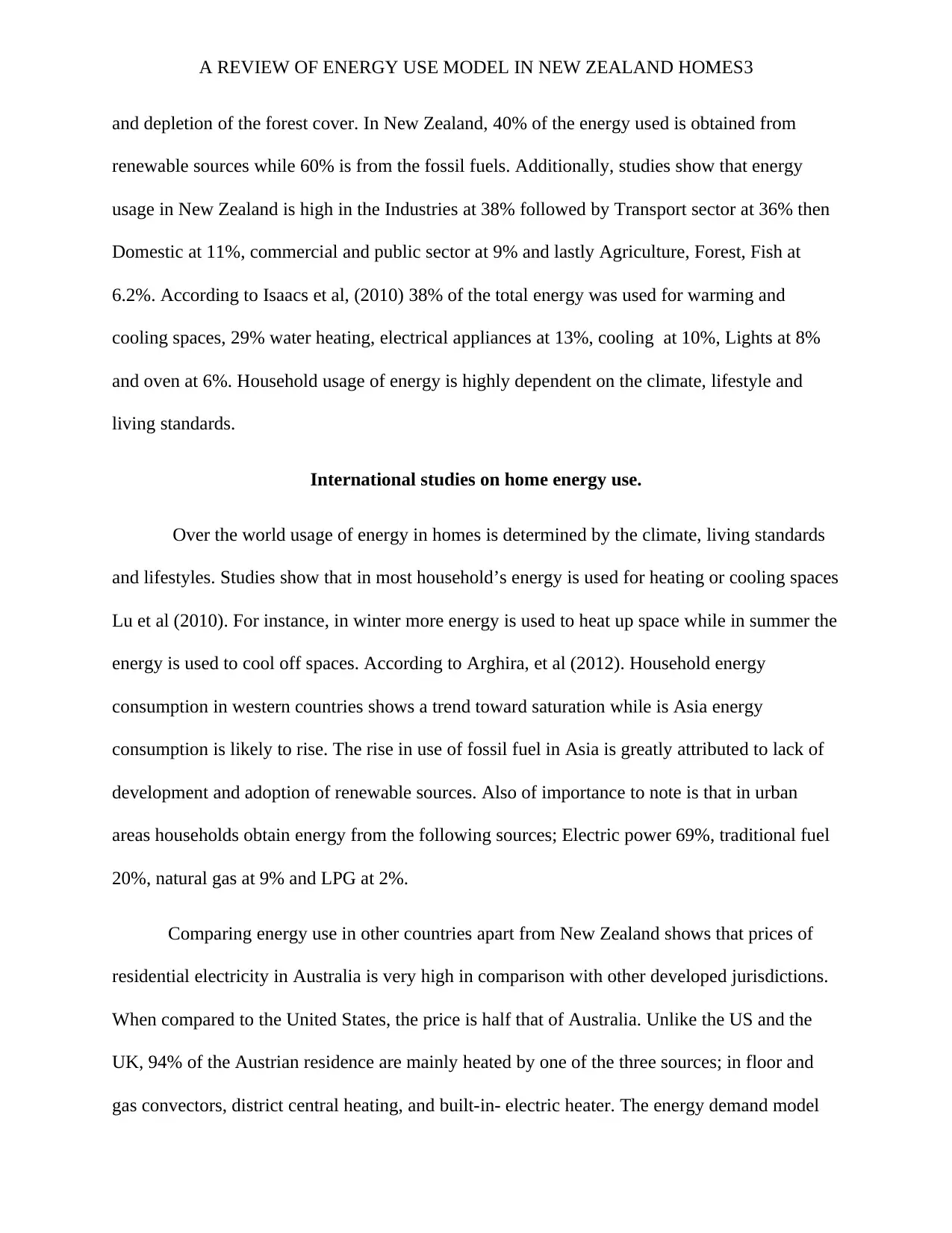
A REVIEW OF ENERGY USE MODEL IN NEW ZEALAND HOMES3
and depletion of the forest cover. In New Zealand, 40% of the energy used is obtained from
renewable sources while 60% is from the fossil fuels. Additionally, studies show that energy
usage in New Zealand is high in the Industries at 38% followed by Transport sector at 36% then
Domestic at 11%, commercial and public sector at 9% and lastly Agriculture, Forest, Fish at
6.2%. According to Isaacs et al, (2010) 38% of the total energy was used for warming and
cooling spaces, 29% water heating, electrical appliances at 13%, cooling at 10%, Lights at 8%
and oven at 6%. Household usage of energy is highly dependent on the climate, lifestyle and
living standards.
International studies on home energy use.
Over the world usage of energy in homes is determined by the climate, living standards
and lifestyles. Studies show that in most household’s energy is used for heating or cooling spaces
Lu et al (2010). For instance, in winter more energy is used to heat up space while in summer the
energy is used to cool off spaces. According to Arghira, et al (2012). Household energy
consumption in western countries shows a trend toward saturation while is Asia energy
consumption is likely to rise. The rise in use of fossil fuel in Asia is greatly attributed to lack of
development and adoption of renewable sources. Also of importance to note is that in urban
areas households obtain energy from the following sources; Electric power 69%, traditional fuel
20%, natural gas at 9% and LPG at 2%.
Comparing energy use in other countries apart from New Zealand shows that prices of
residential electricity in Australia is very high in comparison with other developed jurisdictions.
When compared to the United States, the price is half that of Australia. Unlike the US and the
UK, 94% of the Austrian residence are mainly heated by one of the three sources; in floor and
gas convectors, district central heating, and built-in- electric heater. The energy demand model
and depletion of the forest cover. In New Zealand, 40% of the energy used is obtained from
renewable sources while 60% is from the fossil fuels. Additionally, studies show that energy
usage in New Zealand is high in the Industries at 38% followed by Transport sector at 36% then
Domestic at 11%, commercial and public sector at 9% and lastly Agriculture, Forest, Fish at
6.2%. According to Isaacs et al, (2010) 38% of the total energy was used for warming and
cooling spaces, 29% water heating, electrical appliances at 13%, cooling at 10%, Lights at 8%
and oven at 6%. Household usage of energy is highly dependent on the climate, lifestyle and
living standards.
International studies on home energy use.
Over the world usage of energy in homes is determined by the climate, living standards
and lifestyles. Studies show that in most household’s energy is used for heating or cooling spaces
Lu et al (2010). For instance, in winter more energy is used to heat up space while in summer the
energy is used to cool off spaces. According to Arghira, et al (2012). Household energy
consumption in western countries shows a trend toward saturation while is Asia energy
consumption is likely to rise. The rise in use of fossil fuel in Asia is greatly attributed to lack of
development and adoption of renewable sources. Also of importance to note is that in urban
areas households obtain energy from the following sources; Electric power 69%, traditional fuel
20%, natural gas at 9% and LPG at 2%.
Comparing energy use in other countries apart from New Zealand shows that prices of
residential electricity in Australia is very high in comparison with other developed jurisdictions.
When compared to the United States, the price is half that of Australia. Unlike the US and the
UK, 94% of the Austrian residence are mainly heated by one of the three sources; in floor and
gas convectors, district central heating, and built-in- electric heater. The energy demand model
⊘ This is a preview!⊘
Do you want full access?
Subscribe today to unlock all pages.

Trusted by 1+ million students worldwide
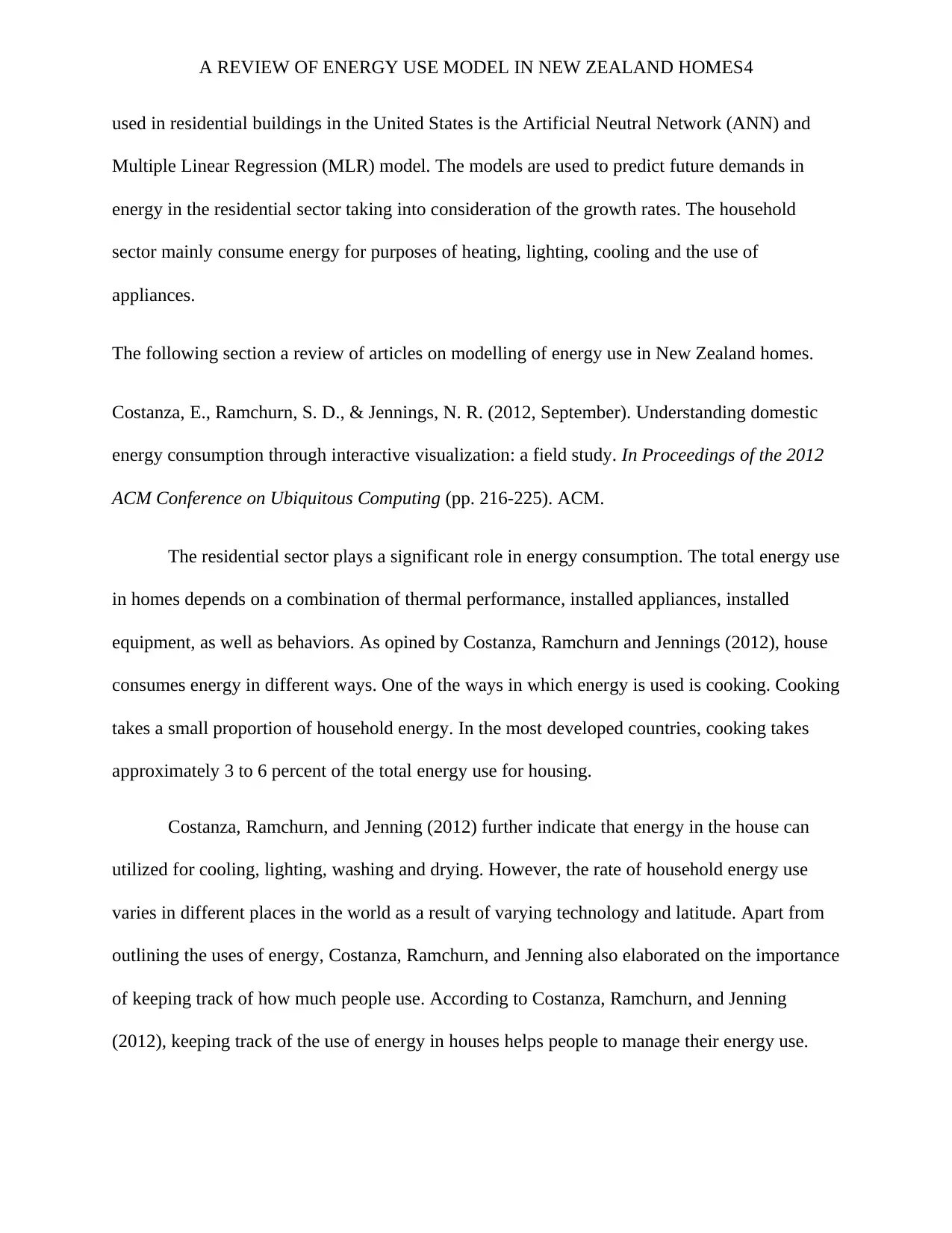
A REVIEW OF ENERGY USE MODEL IN NEW ZEALAND HOMES4
used in residential buildings in the United States is the Artificial Neutral Network (ANN) and
Multiple Linear Regression (MLR) model. The models are used to predict future demands in
energy in the residential sector taking into consideration of the growth rates. The household
sector mainly consume energy for purposes of heating, lighting, cooling and the use of
appliances.
The following section a review of articles on modelling of energy use in New Zealand homes.
Costanza, E., Ramchurn, S. D., & Jennings, N. R. (2012, September). Understanding domestic
energy consumption through interactive visualization: a field study. In Proceedings of the 2012
ACM Conference on Ubiquitous Computing (pp. 216-225). ACM.
The residential sector plays a significant role in energy consumption. The total energy use
in homes depends on a combination of thermal performance, installed appliances, installed
equipment, as well as behaviors. As opined by Costanza, Ramchurn and Jennings (2012), house
consumes energy in different ways. One of the ways in which energy is used is cooking. Cooking
takes a small proportion of household energy. In the most developed countries, cooking takes
approximately 3 to 6 percent of the total energy use for housing.
Costanza, Ramchurn, and Jenning (2012) further indicate that energy in the house can
utilized for cooling, lighting, washing and drying. However, the rate of household energy use
varies in different places in the world as a result of varying technology and latitude. Apart from
outlining the uses of energy, Costanza, Ramchurn, and Jenning also elaborated on the importance
of keeping track of how much people use. According to Costanza, Ramchurn, and Jenning
(2012), keeping track of the use of energy in houses helps people to manage their energy use.
used in residential buildings in the United States is the Artificial Neutral Network (ANN) and
Multiple Linear Regression (MLR) model. The models are used to predict future demands in
energy in the residential sector taking into consideration of the growth rates. The household
sector mainly consume energy for purposes of heating, lighting, cooling and the use of
appliances.
The following section a review of articles on modelling of energy use in New Zealand homes.
Costanza, E., Ramchurn, S. D., & Jennings, N. R. (2012, September). Understanding domestic
energy consumption through interactive visualization: a field study. In Proceedings of the 2012
ACM Conference on Ubiquitous Computing (pp. 216-225). ACM.
The residential sector plays a significant role in energy consumption. The total energy use
in homes depends on a combination of thermal performance, installed appliances, installed
equipment, as well as behaviors. As opined by Costanza, Ramchurn and Jennings (2012), house
consumes energy in different ways. One of the ways in which energy is used is cooking. Cooking
takes a small proportion of household energy. In the most developed countries, cooking takes
approximately 3 to 6 percent of the total energy use for housing.
Costanza, Ramchurn, and Jenning (2012) further indicate that energy in the house can
utilized for cooling, lighting, washing and drying. However, the rate of household energy use
varies in different places in the world as a result of varying technology and latitude. Apart from
outlining the uses of energy, Costanza, Ramchurn, and Jenning also elaborated on the importance
of keeping track of how much people use. According to Costanza, Ramchurn, and Jenning
(2012), keeping track of the use of energy in houses helps people to manage their energy use.
Paraphrase This Document
Need a fresh take? Get an instant paraphrase of this document with our AI Paraphraser
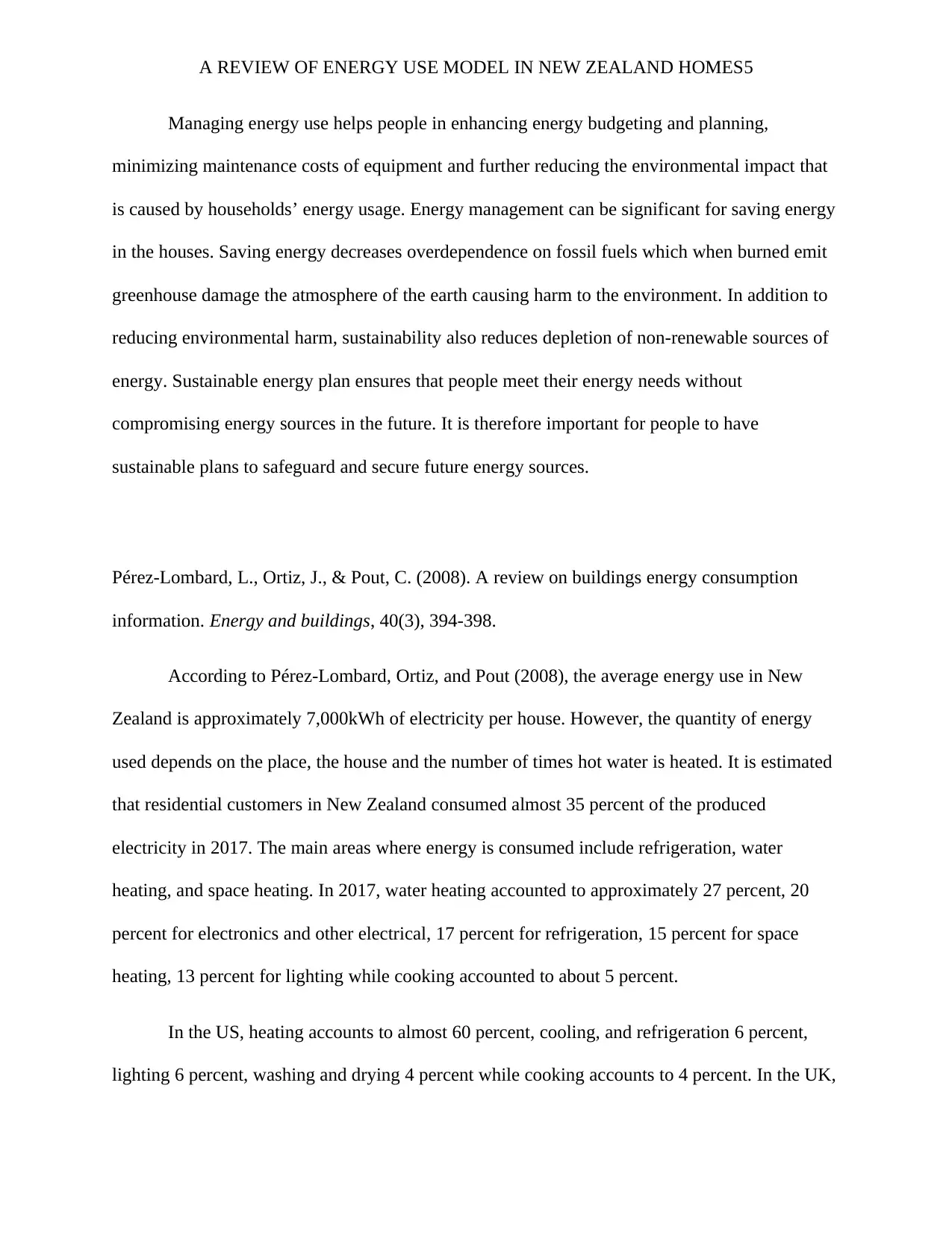
A REVIEW OF ENERGY USE MODEL IN NEW ZEALAND HOMES5
Managing energy use helps people in enhancing energy budgeting and planning,
minimizing maintenance costs of equipment and further reducing the environmental impact that
is caused by households’ energy usage. Energy management can be significant for saving energy
in the houses. Saving energy decreases overdependence on fossil fuels which when burned emit
greenhouse damage the atmosphere of the earth causing harm to the environment. In addition to
reducing environmental harm, sustainability also reduces depletion of non-renewable sources of
energy. Sustainable energy plan ensures that people meet their energy needs without
compromising energy sources in the future. It is therefore important for people to have
sustainable plans to safeguard and secure future energy sources.
Pérez-Lombard, L., Ortiz, J., & Pout, C. (2008). A review on buildings energy consumption
information. Energy and buildings, 40(3), 394-398.
According to Pérez-Lombard, Ortiz, and Pout (2008), the average energy use in New
Zealand is approximately 7,000kWh of electricity per house. However, the quantity of energy
used depends on the place, the house and the number of times hot water is heated. It is estimated
that residential customers in New Zealand consumed almost 35 percent of the produced
electricity in 2017. The main areas where energy is consumed include refrigeration, water
heating, and space heating. In 2017, water heating accounted to approximately 27 percent, 20
percent for electronics and other electrical, 17 percent for refrigeration, 15 percent for space
heating, 13 percent for lighting while cooking accounted to about 5 percent.
In the US, heating accounts to almost 60 percent, cooling, and refrigeration 6 percent,
lighting 6 percent, washing and drying 4 percent while cooking accounts to 4 percent. In the UK,
Managing energy use helps people in enhancing energy budgeting and planning,
minimizing maintenance costs of equipment and further reducing the environmental impact that
is caused by households’ energy usage. Energy management can be significant for saving energy
in the houses. Saving energy decreases overdependence on fossil fuels which when burned emit
greenhouse damage the atmosphere of the earth causing harm to the environment. In addition to
reducing environmental harm, sustainability also reduces depletion of non-renewable sources of
energy. Sustainable energy plan ensures that people meet their energy needs without
compromising energy sources in the future. It is therefore important for people to have
sustainable plans to safeguard and secure future energy sources.
Pérez-Lombard, L., Ortiz, J., & Pout, C. (2008). A review on buildings energy consumption
information. Energy and buildings, 40(3), 394-398.
According to Pérez-Lombard, Ortiz, and Pout (2008), the average energy use in New
Zealand is approximately 7,000kWh of electricity per house. However, the quantity of energy
used depends on the place, the house and the number of times hot water is heated. It is estimated
that residential customers in New Zealand consumed almost 35 percent of the produced
electricity in 2017. The main areas where energy is consumed include refrigeration, water
heating, and space heating. In 2017, water heating accounted to approximately 27 percent, 20
percent for electronics and other electrical, 17 percent for refrigeration, 15 percent for space
heating, 13 percent for lighting while cooking accounted to about 5 percent.
In the US, heating accounts to almost 60 percent, cooling, and refrigeration 6 percent,
lighting 6 percent, washing and drying 4 percent while cooking accounts to 4 percent. In the UK,
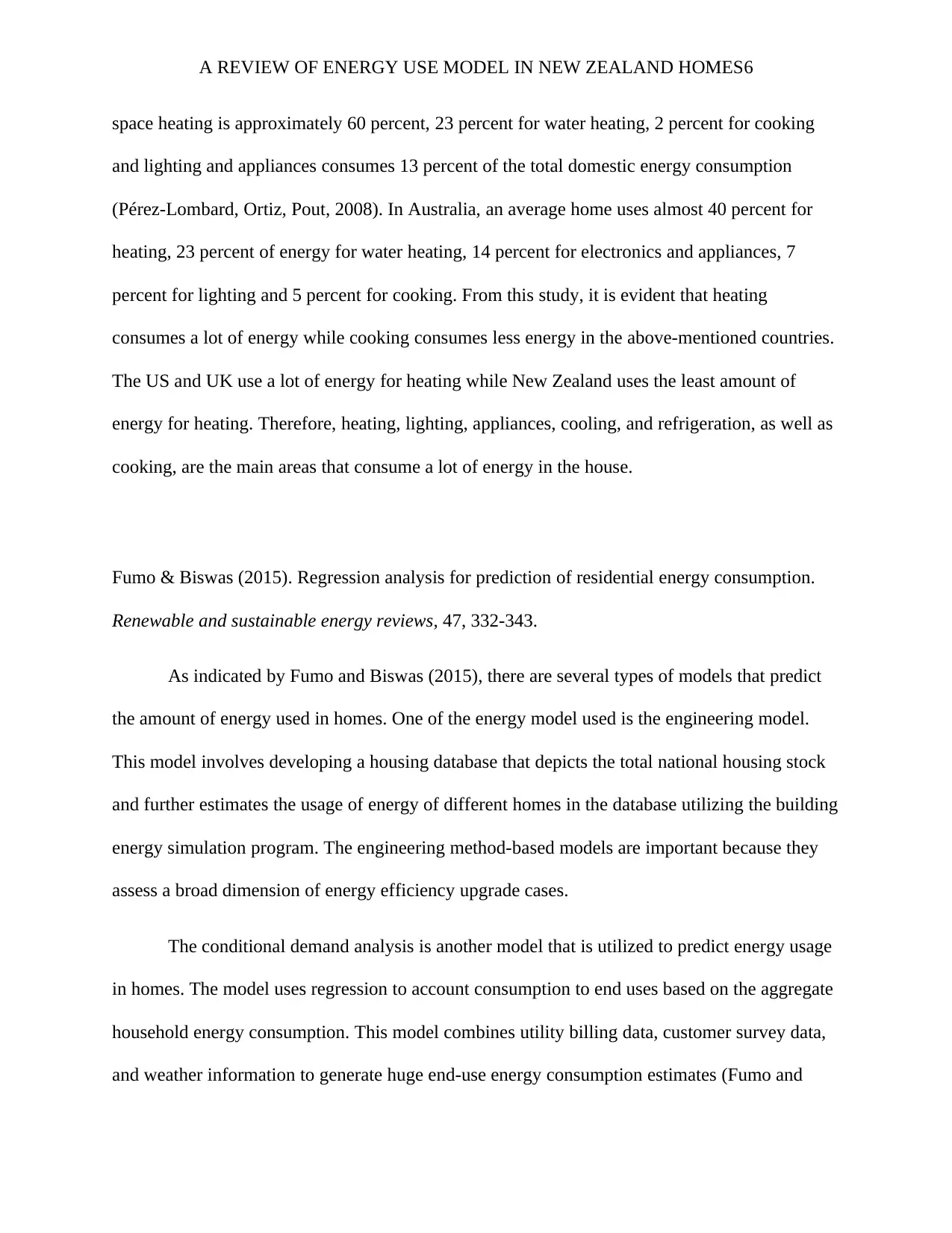
A REVIEW OF ENERGY USE MODEL IN NEW ZEALAND HOMES6
space heating is approximately 60 percent, 23 percent for water heating, 2 percent for cooking
and lighting and appliances consumes 13 percent of the total domestic energy consumption
(Pérez-Lombard, Ortiz, Pout, 2008). In Australia, an average home uses almost 40 percent for
heating, 23 percent of energy for water heating, 14 percent for electronics and appliances, 7
percent for lighting and 5 percent for cooking. From this study, it is evident that heating
consumes a lot of energy while cooking consumes less energy in the above-mentioned countries.
The US and UK use a lot of energy for heating while New Zealand uses the least amount of
energy for heating. Therefore, heating, lighting, appliances, cooling, and refrigeration, as well as
cooking, are the main areas that consume a lot of energy in the house.
Fumo & Biswas (2015). Regression analysis for prediction of residential energy consumption.
Renewable and sustainable energy reviews, 47, 332-343.
As indicated by Fumo and Biswas (2015), there are several types of models that predict
the amount of energy used in homes. One of the energy model used is the engineering model.
This model involves developing a housing database that depicts the total national housing stock
and further estimates the usage of energy of different homes in the database utilizing the building
energy simulation program. The engineering method-based models are important because they
assess a broad dimension of energy efficiency upgrade cases.
The conditional demand analysis is another model that is utilized to predict energy usage
in homes. The model uses regression to account consumption to end uses based on the aggregate
household energy consumption. This model combines utility billing data, customer survey data,
and weather information to generate huge end-use energy consumption estimates (Fumo and
space heating is approximately 60 percent, 23 percent for water heating, 2 percent for cooking
and lighting and appliances consumes 13 percent of the total domestic energy consumption
(Pérez-Lombard, Ortiz, Pout, 2008). In Australia, an average home uses almost 40 percent for
heating, 23 percent of energy for water heating, 14 percent for electronics and appliances, 7
percent for lighting and 5 percent for cooking. From this study, it is evident that heating
consumes a lot of energy while cooking consumes less energy in the above-mentioned countries.
The US and UK use a lot of energy for heating while New Zealand uses the least amount of
energy for heating. Therefore, heating, lighting, appliances, cooling, and refrigeration, as well as
cooking, are the main areas that consume a lot of energy in the house.
Fumo & Biswas (2015). Regression analysis for prediction of residential energy consumption.
Renewable and sustainable energy reviews, 47, 332-343.
As indicated by Fumo and Biswas (2015), there are several types of models that predict
the amount of energy used in homes. One of the energy model used is the engineering model.
This model involves developing a housing database that depicts the total national housing stock
and further estimates the usage of energy of different homes in the database utilizing the building
energy simulation program. The engineering method-based models are important because they
assess a broad dimension of energy efficiency upgrade cases.
The conditional demand analysis is another model that is utilized to predict energy usage
in homes. The model uses regression to account consumption to end uses based on the aggregate
household energy consumption. This model combines utility billing data, customer survey data,
and weather information to generate huge end-use energy consumption estimates (Fumo and
⊘ This is a preview!⊘
Do you want full access?
Subscribe today to unlock all pages.

Trusted by 1+ million students worldwide
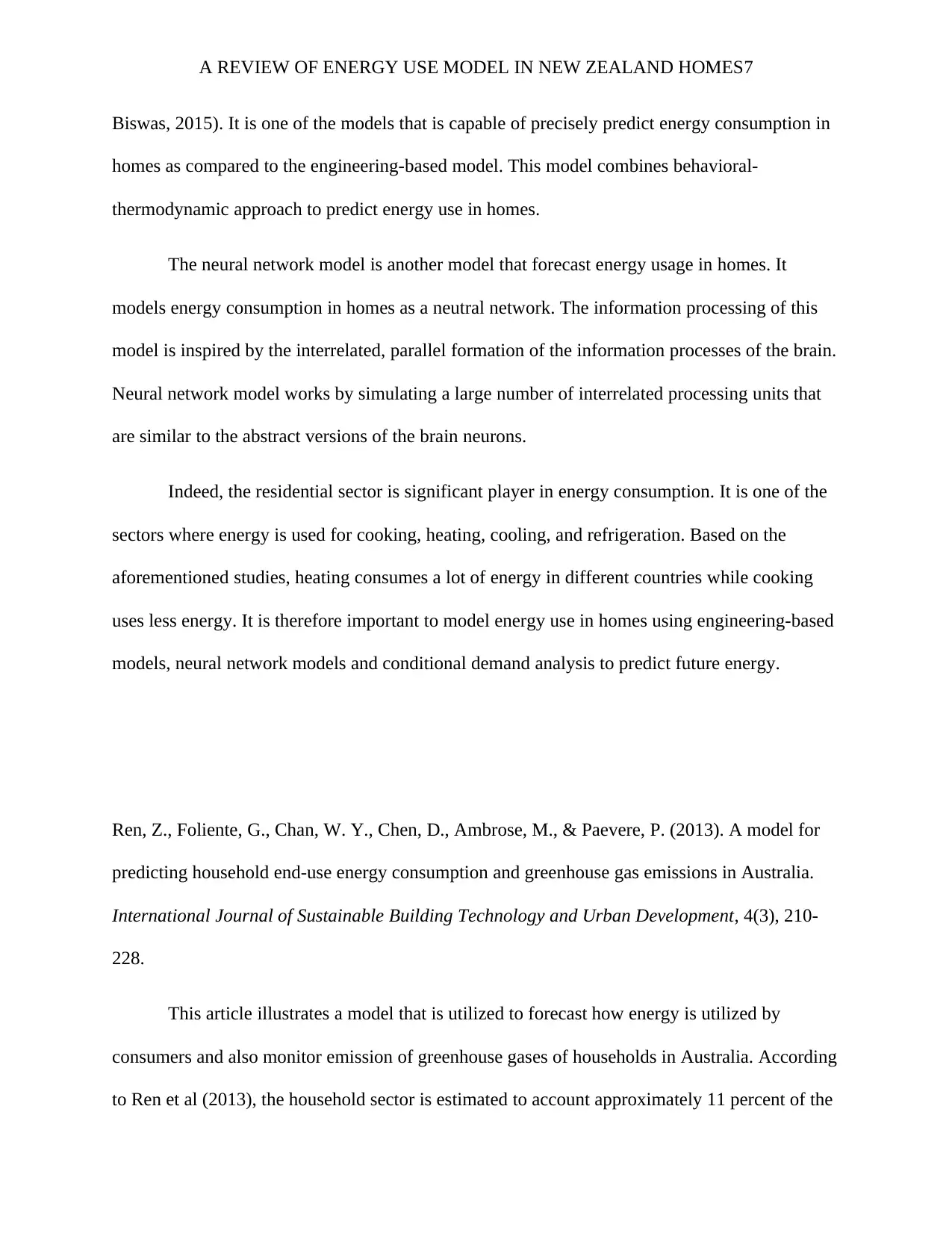
A REVIEW OF ENERGY USE MODEL IN NEW ZEALAND HOMES7
Biswas, 2015). It is one of the models that is capable of precisely predict energy consumption in
homes as compared to the engineering-based model. This model combines behavioral-
thermodynamic approach to predict energy use in homes.
The neural network model is another model that forecast energy usage in homes. It
models energy consumption in homes as a neutral network. The information processing of this
model is inspired by the interrelated, parallel formation of the information processes of the brain.
Neural network model works by simulating a large number of interrelated processing units that
are similar to the abstract versions of the brain neurons.
Indeed, the residential sector is significant player in energy consumption. It is one of the
sectors where energy is used for cooking, heating, cooling, and refrigeration. Based on the
aforementioned studies, heating consumes a lot of energy in different countries while cooking
uses less energy. It is therefore important to model energy use in homes using engineering-based
models, neural network models and conditional demand analysis to predict future energy.
Ren, Z., Foliente, G., Chan, W. Y., Chen, D., Ambrose, M., & Paevere, P. (2013). A model for
predicting household end-use energy consumption and greenhouse gas emissions in Australia.
International Journal of Sustainable Building Technology and Urban Development, 4(3), 210-
228.
This article illustrates a model that is utilized to forecast how energy is utilized by
consumers and also monitor emission of greenhouse gases of households in Australia. According
to Ren et al (2013), the household sector is estimated to account approximately 11 percent of the
Biswas, 2015). It is one of the models that is capable of precisely predict energy consumption in
homes as compared to the engineering-based model. This model combines behavioral-
thermodynamic approach to predict energy use in homes.
The neural network model is another model that forecast energy usage in homes. It
models energy consumption in homes as a neutral network. The information processing of this
model is inspired by the interrelated, parallel formation of the information processes of the brain.
Neural network model works by simulating a large number of interrelated processing units that
are similar to the abstract versions of the brain neurons.
Indeed, the residential sector is significant player in energy consumption. It is one of the
sectors where energy is used for cooking, heating, cooling, and refrigeration. Based on the
aforementioned studies, heating consumes a lot of energy in different countries while cooking
uses less energy. It is therefore important to model energy use in homes using engineering-based
models, neural network models and conditional demand analysis to predict future energy.
Ren, Z., Foliente, G., Chan, W. Y., Chen, D., Ambrose, M., & Paevere, P. (2013). A model for
predicting household end-use energy consumption and greenhouse gas emissions in Australia.
International Journal of Sustainable Building Technology and Urban Development, 4(3), 210-
228.
This article illustrates a model that is utilized to forecast how energy is utilized by
consumers and also monitor emission of greenhouse gases of households in Australia. According
to Ren et al (2013), the household sector is estimated to account approximately 11 percent of the
Paraphrase This Document
Need a fresh take? Get an instant paraphrase of this document with our AI Paraphraser
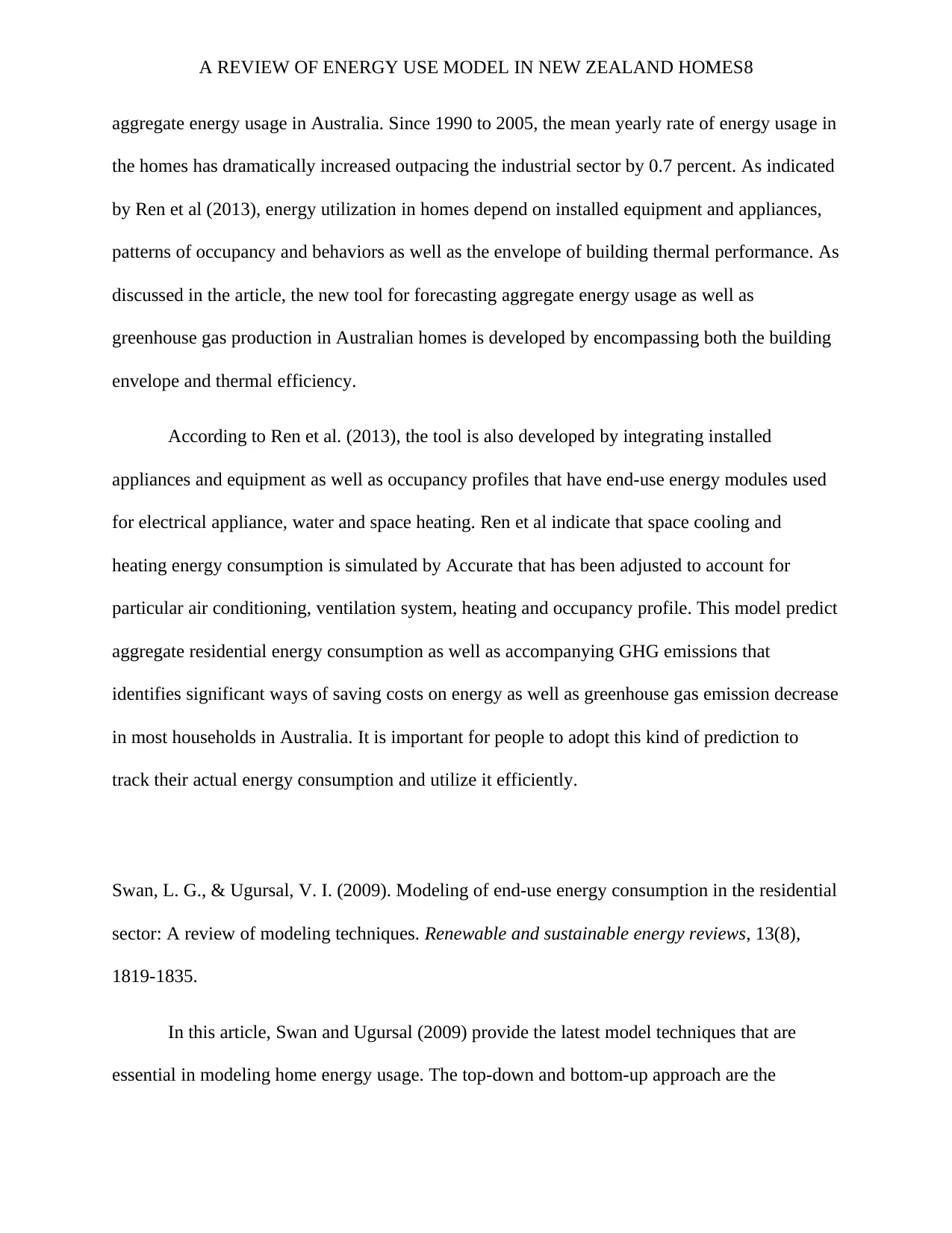
A REVIEW OF ENERGY USE MODEL IN NEW ZEALAND HOMES8
aggregate energy usage in Australia. Since 1990 to 2005, the mean yearly rate of energy usage in
the homes has dramatically increased outpacing the industrial sector by 0.7 percent. As indicated
by Ren et al (2013), energy utilization in homes depend on installed equipment and appliances,
patterns of occupancy and behaviors as well as the envelope of building thermal performance. As
discussed in the article, the new tool for forecasting aggregate energy usage as well as
greenhouse gas production in Australian homes is developed by encompassing both the building
envelope and thermal efficiency.
According to Ren et al. (2013), the tool is also developed by integrating installed
appliances and equipment as well as occupancy profiles that have end-use energy modules used
for electrical appliance, water and space heating. Ren et al indicate that space cooling and
heating energy consumption is simulated by Accurate that has been adjusted to account for
particular air conditioning, ventilation system, heating and occupancy profile. This model predict
aggregate residential energy consumption as well as accompanying GHG emissions that
identifies significant ways of saving costs on energy as well as greenhouse gas emission decrease
in most households in Australia. It is important for people to adopt this kind of prediction to
track their actual energy consumption and utilize it efficiently.
Swan, L. G., & Ugursal, V. I. (2009). Modeling of end-use energy consumption in the residential
sector: A review of modeling techniques. Renewable and sustainable energy reviews, 13(8),
1819-1835.
In this article, Swan and Ugursal (2009) provide the latest model techniques that are
essential in modeling home energy usage. The top-down and bottom-up approach are the
aggregate energy usage in Australia. Since 1990 to 2005, the mean yearly rate of energy usage in
the homes has dramatically increased outpacing the industrial sector by 0.7 percent. As indicated
by Ren et al (2013), energy utilization in homes depend on installed equipment and appliances,
patterns of occupancy and behaviors as well as the envelope of building thermal performance. As
discussed in the article, the new tool for forecasting aggregate energy usage as well as
greenhouse gas production in Australian homes is developed by encompassing both the building
envelope and thermal efficiency.
According to Ren et al. (2013), the tool is also developed by integrating installed
appliances and equipment as well as occupancy profiles that have end-use energy modules used
for electrical appliance, water and space heating. Ren et al indicate that space cooling and
heating energy consumption is simulated by Accurate that has been adjusted to account for
particular air conditioning, ventilation system, heating and occupancy profile. This model predict
aggregate residential energy consumption as well as accompanying GHG emissions that
identifies significant ways of saving costs on energy as well as greenhouse gas emission decrease
in most households in Australia. It is important for people to adopt this kind of prediction to
track their actual energy consumption and utilize it efficiently.
Swan, L. G., & Ugursal, V. I. (2009). Modeling of end-use energy consumption in the residential
sector: A review of modeling techniques. Renewable and sustainable energy reviews, 13(8),
1819-1835.
In this article, Swan and Ugursal (2009) provide the latest model techniques that are
essential in modeling home energy usage. The top-down and bottom-up approach are the
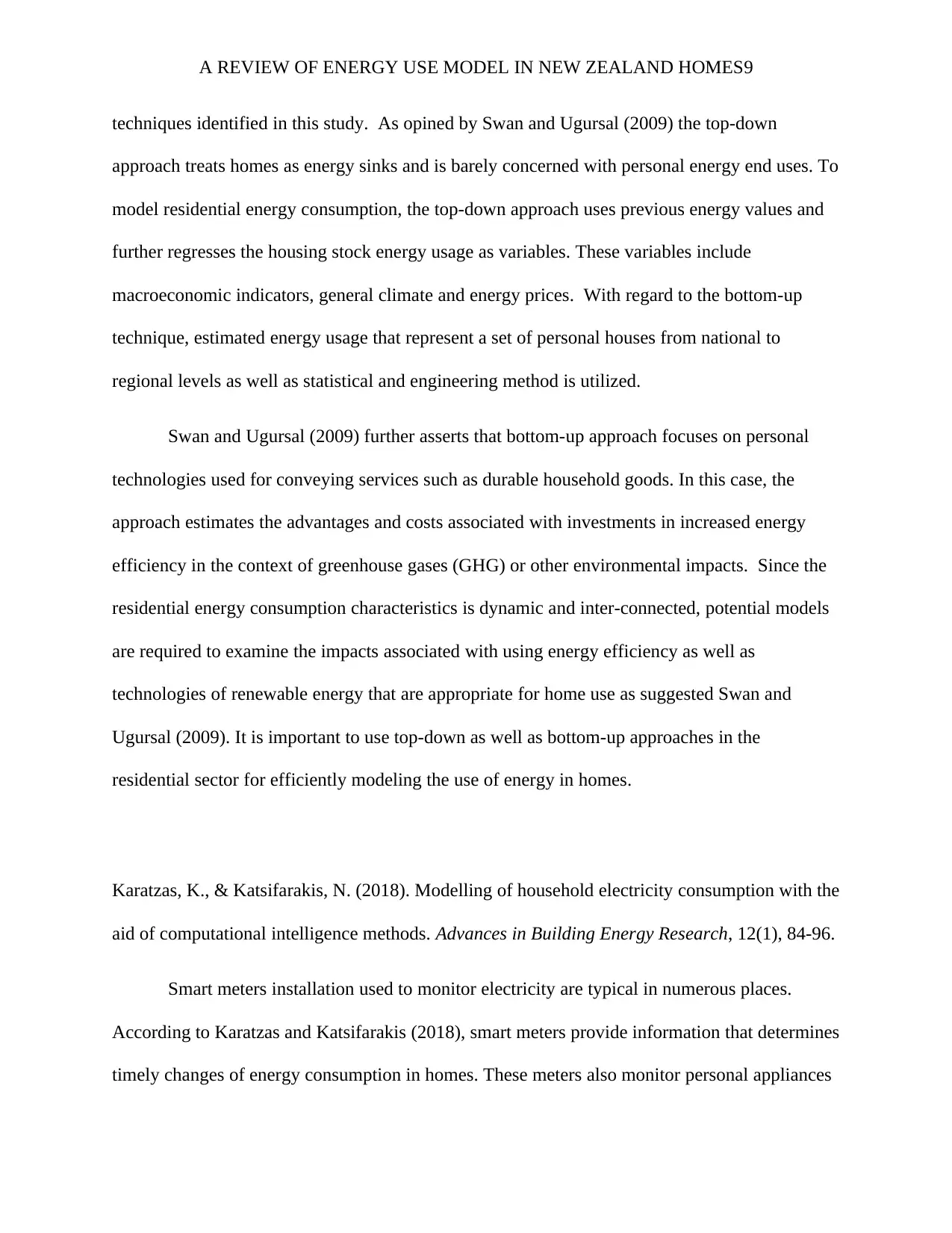
A REVIEW OF ENERGY USE MODEL IN NEW ZEALAND HOMES9
techniques identified in this study. As opined by Swan and Ugursal (2009) the top-down
approach treats homes as energy sinks and is barely concerned with personal energy end uses. To
model residential energy consumption, the top-down approach uses previous energy values and
further regresses the housing stock energy usage as variables. These variables include
macroeconomic indicators, general climate and energy prices. With regard to the bottom-up
technique, estimated energy usage that represent a set of personal houses from national to
regional levels as well as statistical and engineering method is utilized.
Swan and Ugursal (2009) further asserts that bottom-up approach focuses on personal
technologies used for conveying services such as durable household goods. In this case, the
approach estimates the advantages and costs associated with investments in increased energy
efficiency in the context of greenhouse gases (GHG) or other environmental impacts. Since the
residential energy consumption characteristics is dynamic and inter-connected, potential models
are required to examine the impacts associated with using energy efficiency as well as
technologies of renewable energy that are appropriate for home use as suggested Swan and
Ugursal (2009). It is important to use top-down as well as bottom-up approaches in the
residential sector for efficiently modeling the use of energy in homes.
Karatzas, K., & Katsifarakis, N. (2018). Modelling of household electricity consumption with the
aid of computational intelligence methods. Advances in Building Energy Research, 12(1), 84-96.
Smart meters installation used to monitor electricity are typical in numerous places.
According to Karatzas and Katsifarakis (2018), smart meters provide information that determines
timely changes of energy consumption in homes. These meters also monitor personal appliances
techniques identified in this study. As opined by Swan and Ugursal (2009) the top-down
approach treats homes as energy sinks and is barely concerned with personal energy end uses. To
model residential energy consumption, the top-down approach uses previous energy values and
further regresses the housing stock energy usage as variables. These variables include
macroeconomic indicators, general climate and energy prices. With regard to the bottom-up
technique, estimated energy usage that represent a set of personal houses from national to
regional levels as well as statistical and engineering method is utilized.
Swan and Ugursal (2009) further asserts that bottom-up approach focuses on personal
technologies used for conveying services such as durable household goods. In this case, the
approach estimates the advantages and costs associated with investments in increased energy
efficiency in the context of greenhouse gases (GHG) or other environmental impacts. Since the
residential energy consumption characteristics is dynamic and inter-connected, potential models
are required to examine the impacts associated with using energy efficiency as well as
technologies of renewable energy that are appropriate for home use as suggested Swan and
Ugursal (2009). It is important to use top-down as well as bottom-up approaches in the
residential sector for efficiently modeling the use of energy in homes.
Karatzas, K., & Katsifarakis, N. (2018). Modelling of household electricity consumption with the
aid of computational intelligence methods. Advances in Building Energy Research, 12(1), 84-96.
Smart meters installation used to monitor electricity are typical in numerous places.
According to Karatzas and Katsifarakis (2018), smart meters provide information that determines
timely changes of energy consumption in homes. These meters also monitor personal appliances
⊘ This is a preview!⊘
Do you want full access?
Subscribe today to unlock all pages.

Trusted by 1+ million students worldwide
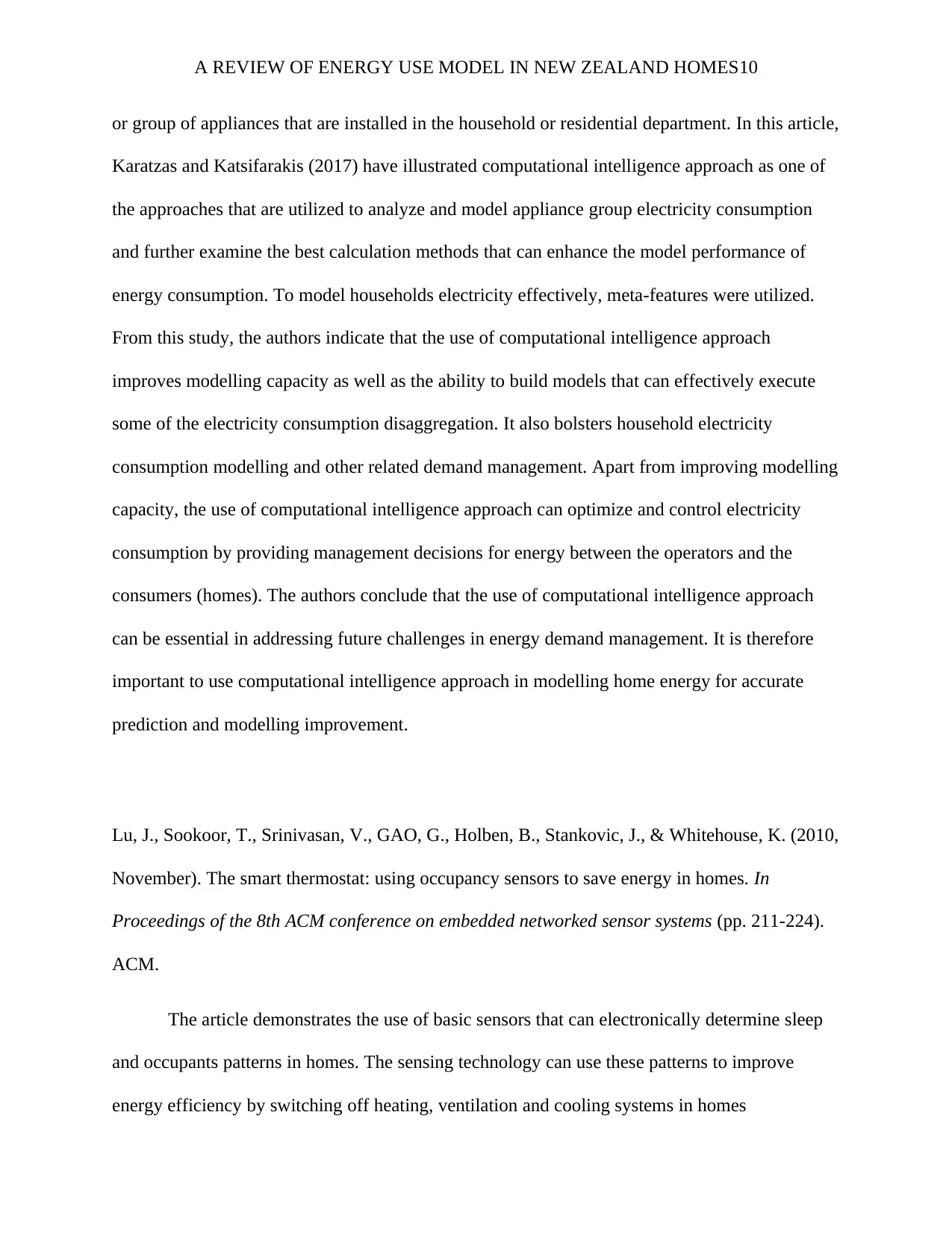
A REVIEW OF ENERGY USE MODEL IN NEW ZEALAND HOMES10
or group of appliances that are installed in the household or residential department. In this article,
Karatzas and Katsifarakis (2017) have illustrated computational intelligence approach as one of
the approaches that are utilized to analyze and model appliance group electricity consumption
and further examine the best calculation methods that can enhance the model performance of
energy consumption. To model households electricity effectively, meta-features were utilized.
From this study, the authors indicate that the use of computational intelligence approach
improves modelling capacity as well as the ability to build models that can effectively execute
some of the electricity consumption disaggregation. It also bolsters household electricity
consumption modelling and other related demand management. Apart from improving modelling
capacity, the use of computational intelligence approach can optimize and control electricity
consumption by providing management decisions for energy between the operators and the
consumers (homes). The authors conclude that the use of computational intelligence approach
can be essential in addressing future challenges in energy demand management. It is therefore
important to use computational intelligence approach in modelling home energy for accurate
prediction and modelling improvement.
Lu, J., Sookoor, T., Srinivasan, V., GAO, G., Holben, B., Stankovic, J., & Whitehouse, K. (2010,
November). The smart thermostat: using occupancy sensors to save energy in homes. In
Proceedings of the 8th ACM conference on embedded networked sensor systems (pp. 211-224).
ACM.
The article demonstrates the use of basic sensors that can electronically determine sleep
and occupants patterns in homes. The sensing technology can use these patterns to improve
energy efficiency by switching off heating, ventilation and cooling systems in homes
or group of appliances that are installed in the household or residential department. In this article,
Karatzas and Katsifarakis (2017) have illustrated computational intelligence approach as one of
the approaches that are utilized to analyze and model appliance group electricity consumption
and further examine the best calculation methods that can enhance the model performance of
energy consumption. To model households electricity effectively, meta-features were utilized.
From this study, the authors indicate that the use of computational intelligence approach
improves modelling capacity as well as the ability to build models that can effectively execute
some of the electricity consumption disaggregation. It also bolsters household electricity
consumption modelling and other related demand management. Apart from improving modelling
capacity, the use of computational intelligence approach can optimize and control electricity
consumption by providing management decisions for energy between the operators and the
consumers (homes). The authors conclude that the use of computational intelligence approach
can be essential in addressing future challenges in energy demand management. It is therefore
important to use computational intelligence approach in modelling home energy for accurate
prediction and modelling improvement.
Lu, J., Sookoor, T., Srinivasan, V., GAO, G., Holben, B., Stankovic, J., & Whitehouse, K. (2010,
November). The smart thermostat: using occupancy sensors to save energy in homes. In
Proceedings of the 8th ACM conference on embedded networked sensor systems (pp. 211-224).
ACM.
The article demonstrates the use of basic sensors that can electronically determine sleep
and occupants patterns in homes. The sensing technology can use these patterns to improve
energy efficiency by switching off heating, ventilation and cooling systems in homes
Paraphrase This Document
Need a fresh take? Get an instant paraphrase of this document with our AI Paraphraser
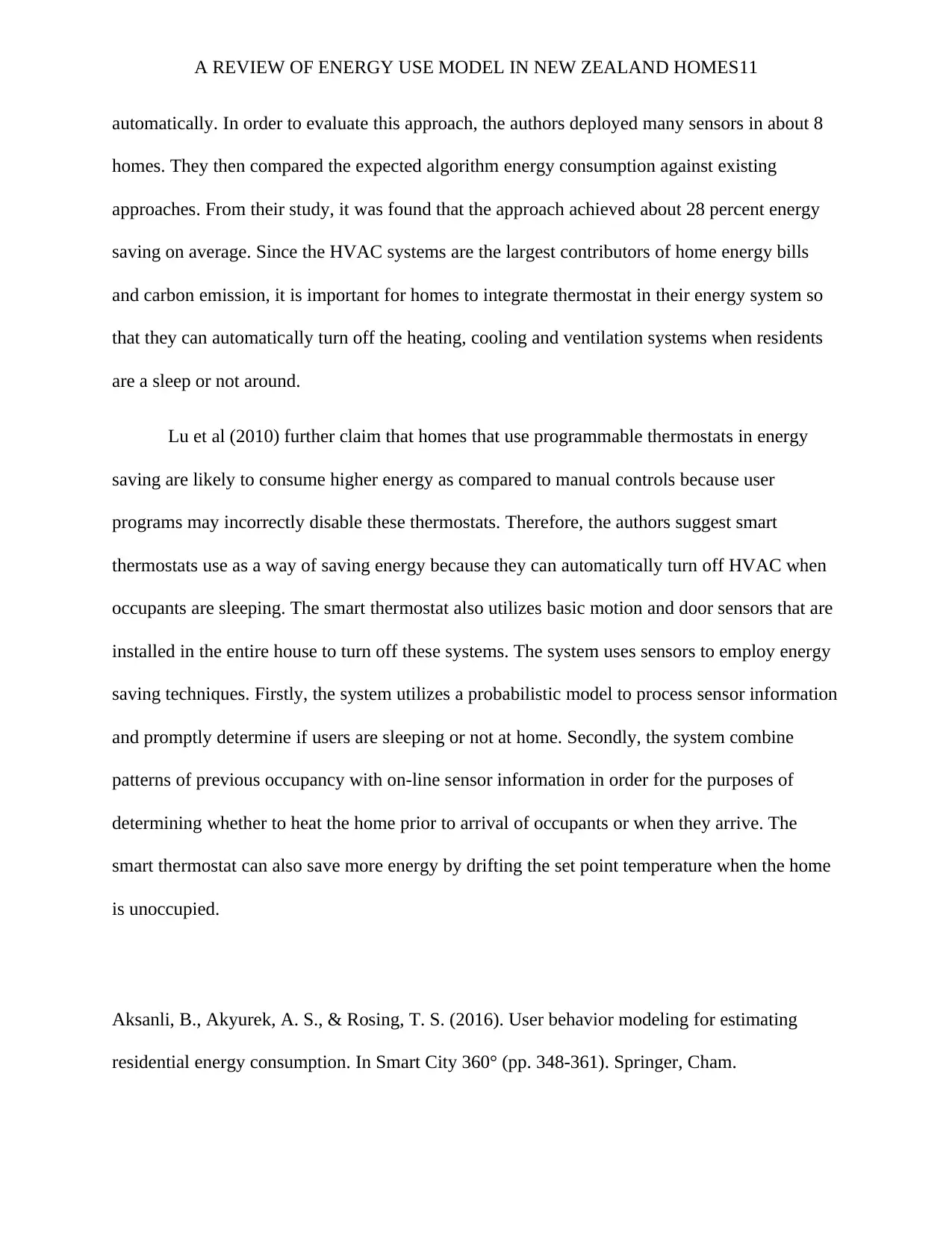
A REVIEW OF ENERGY USE MODEL IN NEW ZEALAND HOMES11
automatically. In order to evaluate this approach, the authors deployed many sensors in about 8
homes. They then compared the expected algorithm energy consumption against existing
approaches. From their study, it was found that the approach achieved about 28 percent energy
saving on average. Since the HVAC systems are the largest contributors of home energy bills
and carbon emission, it is important for homes to integrate thermostat in their energy system so
that they can automatically turn off the heating, cooling and ventilation systems when residents
are a sleep or not around.
Lu et al (2010) further claim that homes that use programmable thermostats in energy
saving are likely to consume higher energy as compared to manual controls because user
programs may incorrectly disable these thermostats. Therefore, the authors suggest smart
thermostats use as a way of saving energy because they can automatically turn off HVAC when
occupants are sleeping. The smart thermostat also utilizes basic motion and door sensors that are
installed in the entire house to turn off these systems. The system uses sensors to employ energy
saving techniques. Firstly, the system utilizes a probabilistic model to process sensor information
and promptly determine if users are sleeping or not at home. Secondly, the system combine
patterns of previous occupancy with on-line sensor information in order for the purposes of
determining whether to heat the home prior to arrival of occupants or when they arrive. The
smart thermostat can also save more energy by drifting the set point temperature when the home
is unoccupied.
Aksanli, B., Akyurek, A. S., & Rosing, T. S. (2016). User behavior modeling for estimating
residential energy consumption. In Smart City 360° (pp. 348-361). Springer, Cham.
automatically. In order to evaluate this approach, the authors deployed many sensors in about 8
homes. They then compared the expected algorithm energy consumption against existing
approaches. From their study, it was found that the approach achieved about 28 percent energy
saving on average. Since the HVAC systems are the largest contributors of home energy bills
and carbon emission, it is important for homes to integrate thermostat in their energy system so
that they can automatically turn off the heating, cooling and ventilation systems when residents
are a sleep or not around.
Lu et al (2010) further claim that homes that use programmable thermostats in energy
saving are likely to consume higher energy as compared to manual controls because user
programs may incorrectly disable these thermostats. Therefore, the authors suggest smart
thermostats use as a way of saving energy because they can automatically turn off HVAC when
occupants are sleeping. The smart thermostat also utilizes basic motion and door sensors that are
installed in the entire house to turn off these systems. The system uses sensors to employ energy
saving techniques. Firstly, the system utilizes a probabilistic model to process sensor information
and promptly determine if users are sleeping or not at home. Secondly, the system combine
patterns of previous occupancy with on-line sensor information in order for the purposes of
determining whether to heat the home prior to arrival of occupants or when they arrive. The
smart thermostat can also save more energy by drifting the set point temperature when the home
is unoccupied.
Aksanli, B., Akyurek, A. S., & Rosing, T. S. (2016). User behavior modeling for estimating
residential energy consumption. In Smart City 360° (pp. 348-361). Springer, Cham.
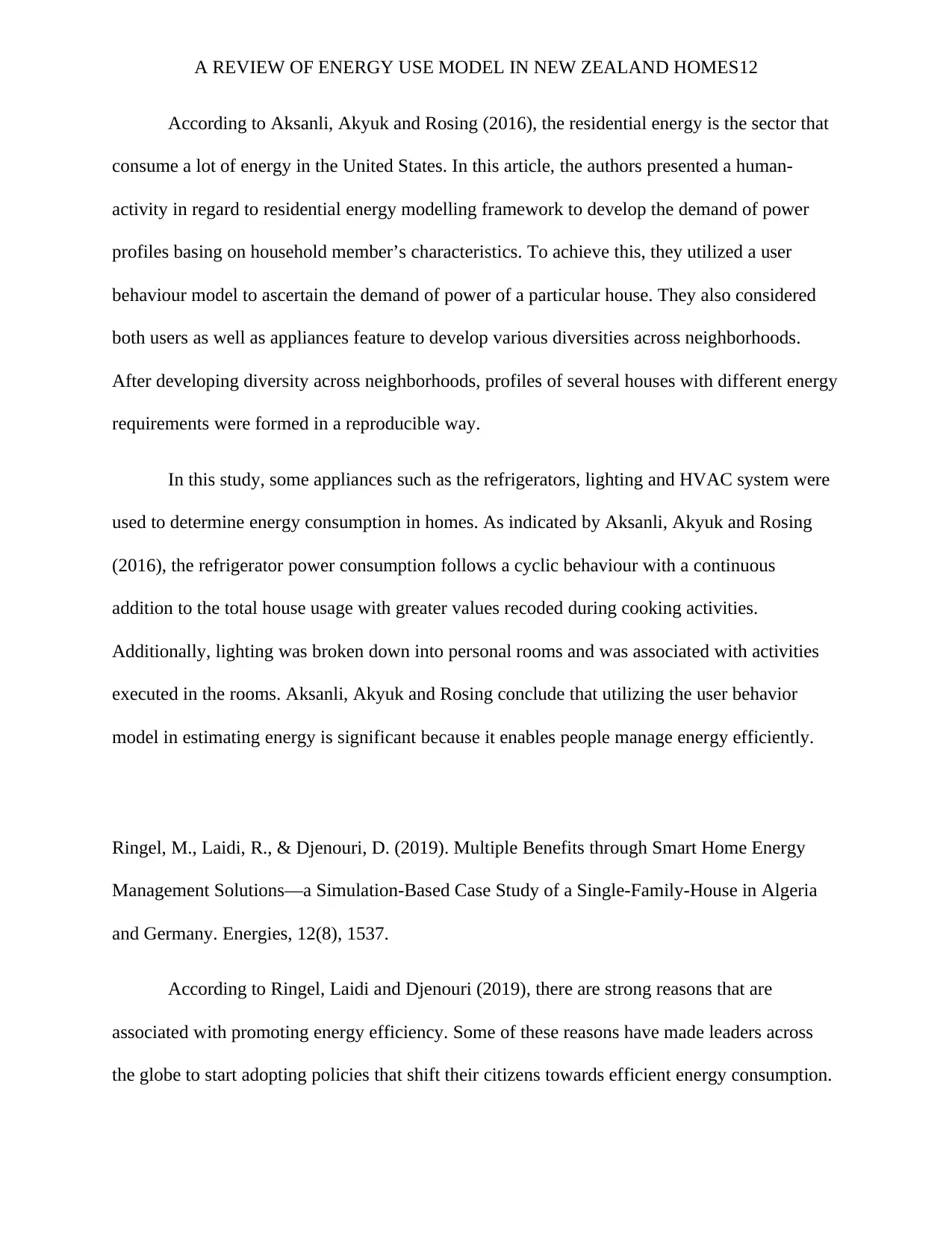
A REVIEW OF ENERGY USE MODEL IN NEW ZEALAND HOMES12
According to Aksanli, Akyuk and Rosing (2016), the residential energy is the sector that
consume a lot of energy in the United States. In this article, the authors presented a human-
activity in regard to residential energy modelling framework to develop the demand of power
profiles basing on household member’s characteristics. To achieve this, they utilized a user
behaviour model to ascertain the demand of power of a particular house. They also considered
both users as well as appliances feature to develop various diversities across neighborhoods.
After developing diversity across neighborhoods, profiles of several houses with different energy
requirements were formed in a reproducible way.
In this study, some appliances such as the refrigerators, lighting and HVAC system were
used to determine energy consumption in homes. As indicated by Aksanli, Akyuk and Rosing
(2016), the refrigerator power consumption follows a cyclic behaviour with a continuous
addition to the total house usage with greater values recoded during cooking activities.
Additionally, lighting was broken down into personal rooms and was associated with activities
executed in the rooms. Aksanli, Akyuk and Rosing conclude that utilizing the user behavior
model in estimating energy is significant because it enables people manage energy efficiently.
Ringel, M., Laidi, R., & Djenouri, D. (2019). Multiple Benefits through Smart Home Energy
Management Solutions—a Simulation-Based Case Study of a Single-Family-House in Algeria
and Germany. Energies, 12(8), 1537.
According to Ringel, Laidi and Djenouri (2019), there are strong reasons that are
associated with promoting energy efficiency. Some of these reasons have made leaders across
the globe to start adopting policies that shift their citizens towards efficient energy consumption.
According to Aksanli, Akyuk and Rosing (2016), the residential energy is the sector that
consume a lot of energy in the United States. In this article, the authors presented a human-
activity in regard to residential energy modelling framework to develop the demand of power
profiles basing on household member’s characteristics. To achieve this, they utilized a user
behaviour model to ascertain the demand of power of a particular house. They also considered
both users as well as appliances feature to develop various diversities across neighborhoods.
After developing diversity across neighborhoods, profiles of several houses with different energy
requirements were formed in a reproducible way.
In this study, some appliances such as the refrigerators, lighting and HVAC system were
used to determine energy consumption in homes. As indicated by Aksanli, Akyuk and Rosing
(2016), the refrigerator power consumption follows a cyclic behaviour with a continuous
addition to the total house usage with greater values recoded during cooking activities.
Additionally, lighting was broken down into personal rooms and was associated with activities
executed in the rooms. Aksanli, Akyuk and Rosing conclude that utilizing the user behavior
model in estimating energy is significant because it enables people manage energy efficiently.
Ringel, M., Laidi, R., & Djenouri, D. (2019). Multiple Benefits through Smart Home Energy
Management Solutions—a Simulation-Based Case Study of a Single-Family-House in Algeria
and Germany. Energies, 12(8), 1537.
According to Ringel, Laidi and Djenouri (2019), there are strong reasons that are
associated with promoting energy efficiency. Some of these reasons have made leaders across
the globe to start adopting policies that shift their citizens towards efficient energy consumption.
⊘ This is a preview!⊘
Do you want full access?
Subscribe today to unlock all pages.

Trusted by 1+ million students worldwide
1 out of 56
Related Documents
Your All-in-One AI-Powered Toolkit for Academic Success.
+13062052269
info@desklib.com
Available 24*7 on WhatsApp / Email
![[object Object]](/_next/static/media/star-bottom.7253800d.svg)
Unlock your academic potential
Copyright © 2020–2025 A2Z Services. All Rights Reserved. Developed and managed by ZUCOL.




